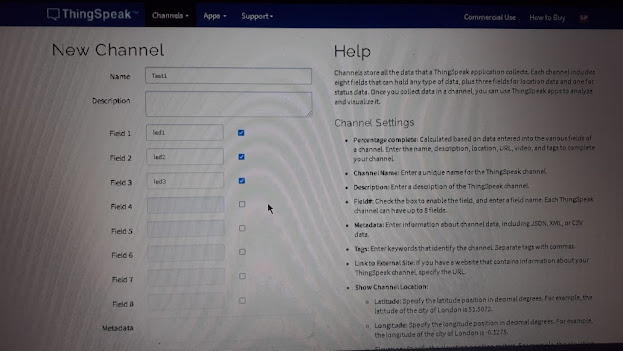Controll an led over the internet.(IOT)Internert of things
CONTROL AN LED'S USING NODEMCU AND THINGSPEAK.
There are some steps to make this project:
- Make an account on https://thingspeak.com/.
- create channel on thingspeak.
- Fullfill the code required credentials.
- upload the code to Nodemcu Esp8266 Development Board
.
Materials required for this project:
- Nodemcu Esp8266 Development Board
.
- 5 mm LEDs (White, Green, Red, Yellow and Blue)
Any of these.
- Jumper Wires Male to Male.
- Bread Board.
- Laptop for uploading the code to Nodemcu.
Make an account on https://thingspeak.com/.
- Go to Google.com and Search for https://thingspeak.com/.
- Click on Get Started For Free.
- Click on New Channel.
Fine you are all set to og for the coding part.
Upload the code to Nodemcu Esp8266 Development Board .
.
//Welcome to Smarthub100---SUBSCRIBE Now
#include "ThingSpeak.h"
#include <ESP8266WiFi.h>
//Replace your wifi credentials here
const char* ssid = "Sohail";//Replace with your Wifi Name
const char* password = "11110000";// Replace with your wifi Password
//change your channel number here
unsigned long channel =1138780;//Replace with your own ThingSpeak Account Channle ID
//1,2 and 3 are channel fields. You don't need to change if you are following this tutorial. However, you can modify it according to your application
unsigned int led1 = 1;
unsigned int led2 = 2;
unsigned int led3 = 3;
WiFiClient client;
void setup() {
Serial.begin(115200);
delay(100);
pinMode(D1, OUTPUT);
pinMode(D2, OUTPUT);
pinMode(D3, OUTPUT);
digitalWrite(D1, 0);
digitalWrite(D2, 0);
digitalWrite(D3, 0);
// We start by connecting to a WiFi network
Serial.println();
Serial.println();
Serial.print("Connecting to ");
Serial.println(ssid);
WiFi.begin(ssid, password);
while (WiFi.status() != WL_CONNECTED) {
delay(500);
Serial.print(".");
}
Serial.println("");
Serial.println("WiFi connected");
Serial.println("IP address: ");
Serial.println(WiFi.localIP());
Serial.print("Netmask: ");
Serial.println(WiFi.subnetMask());
Serial.print("Gateway: ");
Serial.println(WiFi.gatewayIP());
ThingSpeak.begin(client);
}
void loop() {
//get the last data of the fields
int led_1 = ThingSpeak.readFloatField(channel, led1);
int led_2 = ThingSpeak.readFloatField(channel, led2);
int led_3 = ThingSpeak.readFloatField(channel, led3);
if(led_1 == 1){
digitalWrite(D1, 1);
Serial.println("D1 is On..!");
}
else if(led_1 == 0){
digitalWrite(D1, 0);
Serial.println("D1 is Off..!");
}
if(led_2 == 1){
digitalWrite(D2, 1);
Serial.println("D2 is On..!");
}
else if(led_2 == 0){
digitalWrite(D2, 0);
Serial.println("D2 is Off..!");
}
if(led_3 == 1){
digitalWrite(D3, 1);
Serial.println("D3 is On..!");
}
else if(led_3 == 0){
digitalWrite(D3, 0);
Serial.println("D3 is Off..!");
}
Serial.println(led_1);
Serial.println(led_2);
Serial.println(led_3);
delay(3000);
}
- Go to API Key and copy the link and paste it in the search bar and search.













Comments
Post a Comment